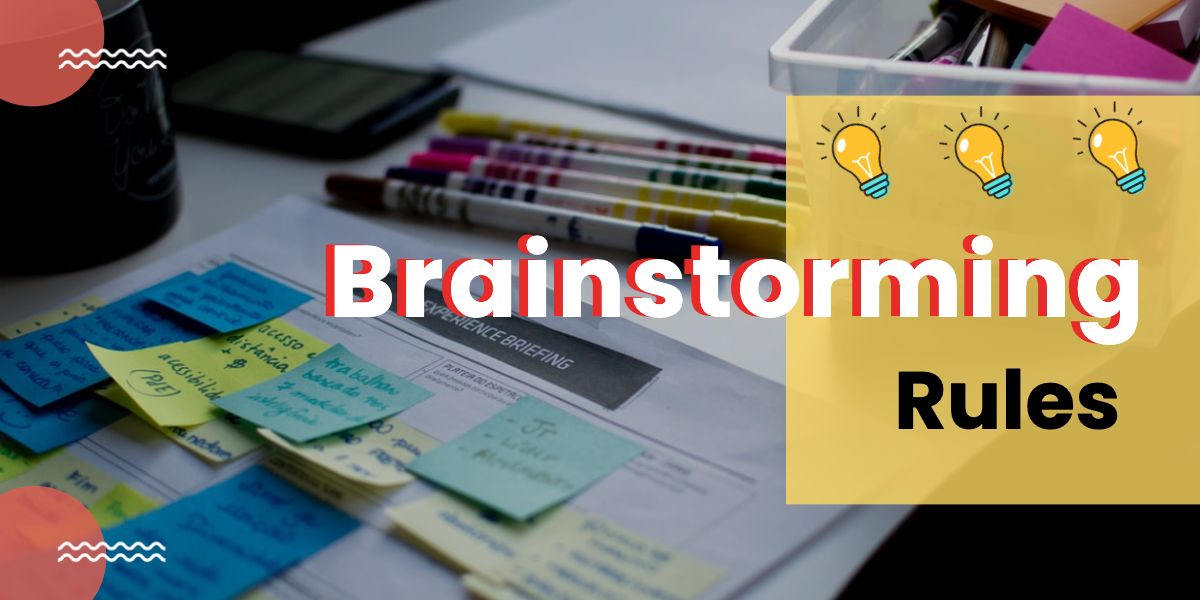“Brainstorming” as a concept was originally devised by Alex Osborn as a group ideation activity. Today, many people just consider individual idea generating (or thinking) as brainstorming – when it was originally meant to be a group experience…a brainstorming session. Alex Osborn’s book Applied Imagination: Principles and Procedures of Creative Problem-Solving is a classic foundational text if you’d like to get into the origins. Today, a brainstorming session can still be a powerful activity for a group to generate ideas together, if the session is guided by guidelines that are introduced before starting.
What are the Rules for Brainstorming?
Original Brainstorming Session Rules
There are brainstorming rules that guide the activity and are announced by the facilitator before beginning the session. Osborn identified these four rules as:
1. No evaluation or criticism of ideas is permitted, to ensure that people are more concerned to generate, rather than defend, ideas.
2. Participants are encouraged to suggest the most outrageous solutions they can conceive, on the assumption that these may often contain kernels of truth that can be extracted during the analysis session.
3. As many ideas as can be thought of are voiced, in the belief that out of quantity will come quality.
4. Participants attempt to build upon, integrate, and develop ideas that have already been voiced in the session.
IDEO Brainstorming Rules
IDEO has become a popular source for design thinking and human-centered design information. IDEO’s rules of brainstorming are well-known in the innovation community. They are as follows. Note the similarities with Osborn’s original rules and some of their very practical, simple, and action-oriented wording that builds on the original brainstorming session activity guidelines.
1. Defer Judgment: Creative spaces are judgment-free zones—they let ideas flow so people can build from each other’s great ideas.
2. Encourage Wild Ideas: Embrace the most out-of-the-box notions. There’s often not a whole lot of difference between outrageous and brilliant.
3. Build on the Ideas of Others: Try to use “and” instead of “but,” it encourages positivity and inclusivity and leads to tons of ideas.
4. Stay Focused on the Topic: Try to keep the discussion on target. Divergence is good, but you still need to keep your eyes on the prize.
5. One Conversation at a Time: This can be difficult—especially with lots of creative people in a single room—but always think about the challenge topic and how to stay on track.
6. Be Visual: Use colored markers and Post-its. Stick your ideas on the wall so others can visualize them.
7. Go for Quantity: Crank your ideas out quickly. For any 60-minute session, you should try to generate 100 ideas.
Why set rules for brainstorming?
From our experience of designing and facilitating hundreds of brainstorming workshops and sessions, having rules helps people understand what the activity is…and how a group brainstorming session is much different than your usual group conversation or meeting. It only takes a few minutes to post and read the rules so why not give it a try and see if people “play by the brainstorming rules” and help you get much better outcomes from your brainstorming session. The outcomes could simply be more and better ideas.
The next time you bring a group of people together for ideation, try a brainstorming session. Select some rules from above and introduce them. You can just stick to Osborn’s original rules which still work great decades later. You can simplify them too. Based on our experience building a professional brainstorming organization called BrainReactions, I’ve used these simple guidelines for great group idea generating effects:
1. Don’t judge your own ideas or the ideas of others.
2. List a large quantity of ideas that you capture yourself.
3. Make connections using questions, tools, and ideas you heard from others to catalyze more ideas.
Try the inspiration from above to put the brainstorming rules in your own words for your own group. Keep experimenting to see what works. The first experiment to run is testing to see if posting and introducing the rules leads to better group idea generating. I bet it will! We are always experimenting with better ways for group brainstorming, innovation and design thinking. We’ve taken a decade of insights on better brainstorming and turned it into a brainstorming training online course. Check it out! We hope this idea generation deep dive will help you to brainstorm a new idea…especially a wild idea or creative idea that makes a difference. Gain a new brainstorming technique, method, and process that you can apply for divergent thinking. Brainstorming rules can help.
Reach out to us if you’d like help designing or facilitating the big brainstorming session for your organization.
